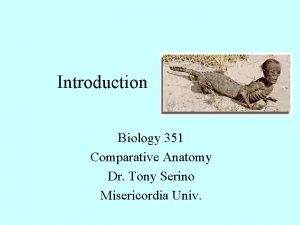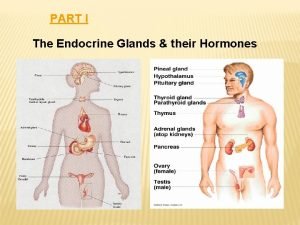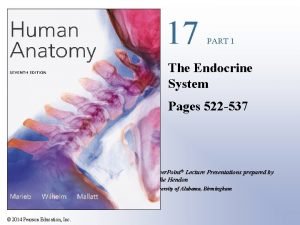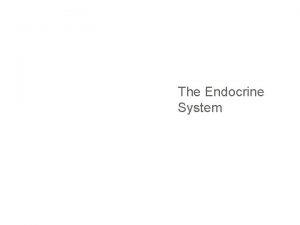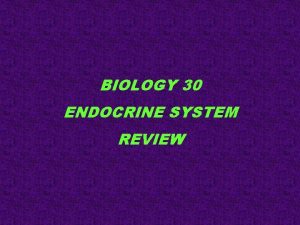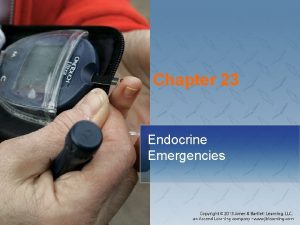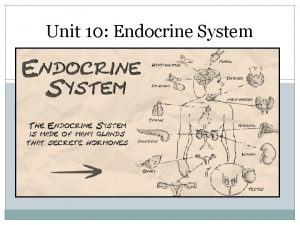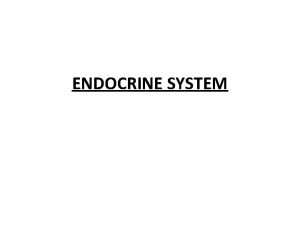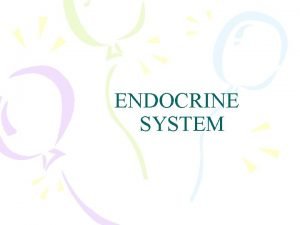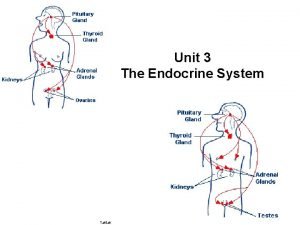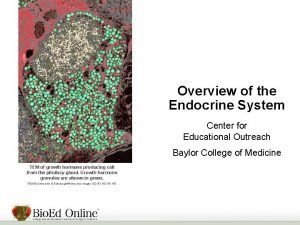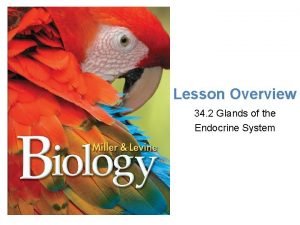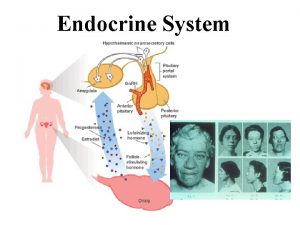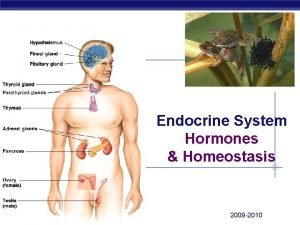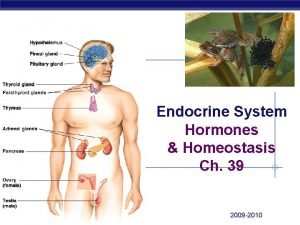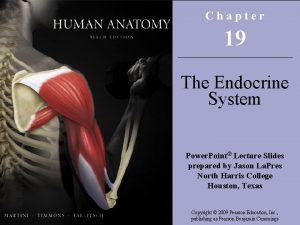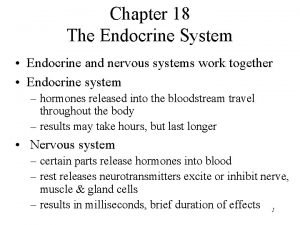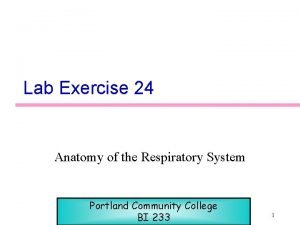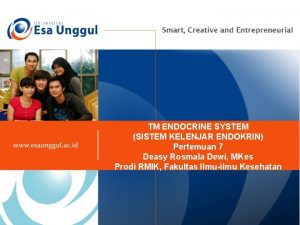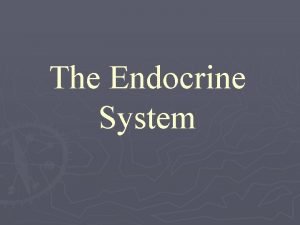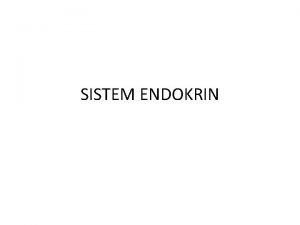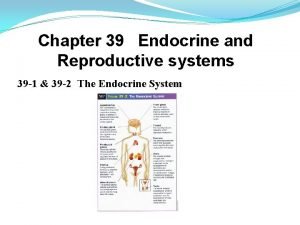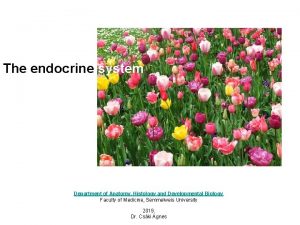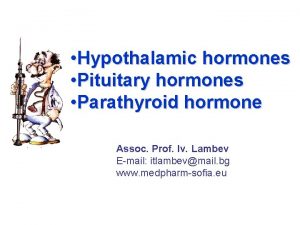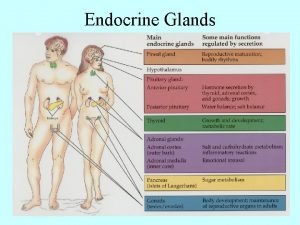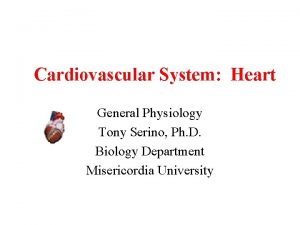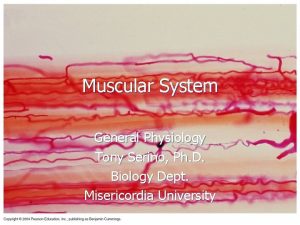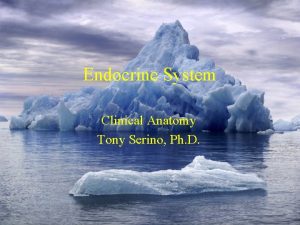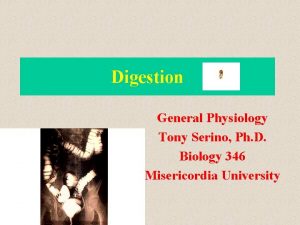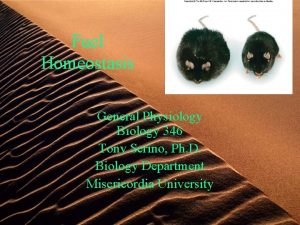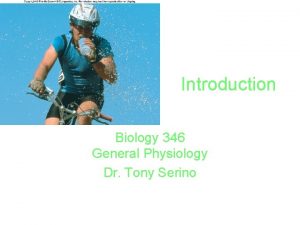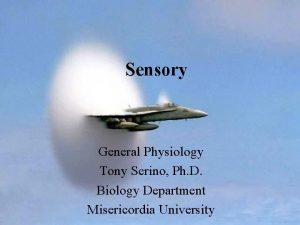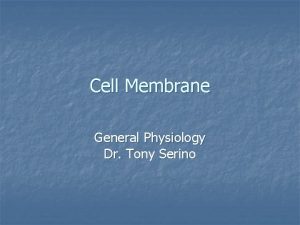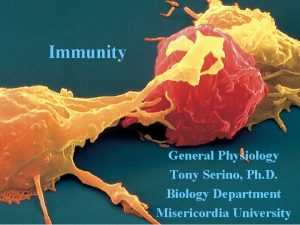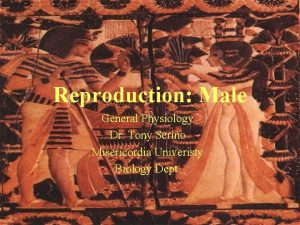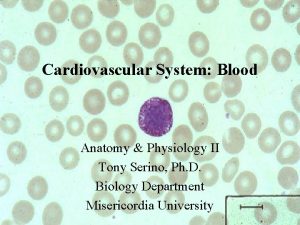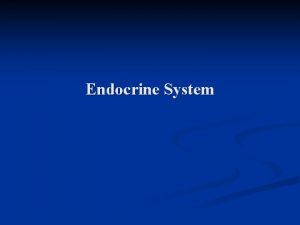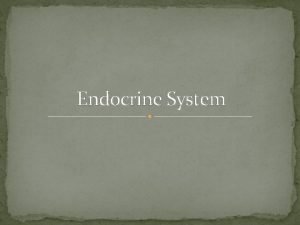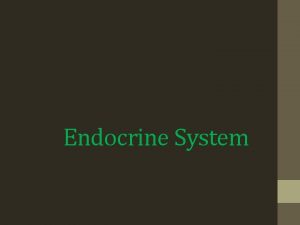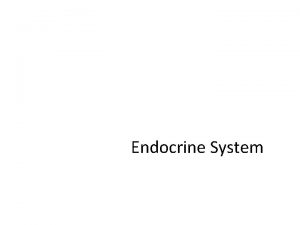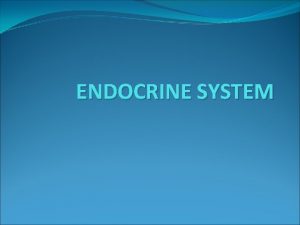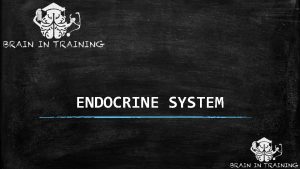Endocrine System General Physiology Tony Serino Ph D


























































- Slides: 58

Endocrine System General Physiology Tony Serino, Ph. D. Biology Department College Misericordia

Endocrine System • Controls and modifies the internal environment by releasing chemicals (hormones) into the blood • Slower response time but longer duration of action compared to nervous system

Chemical Messengers (hormones) • Hormone –secreted by cell into blood and acts on another cell some distance away • Neurohormone –secreted by neuron into blood to affect a target cell some distance away • Local hormones –secreted by cell into interstitial fluid to affects cells nearby – Paracrines –affect neighboring cells – Autocrines –affect the secreting cell • Pheromones –secreted by cell onto body surface to affect cells of another individual

Hormones • Chemical Classification – Amines –single or few amino acids, most water soluble • Epinephrine, Thyroxine (but water insoluble), Melatonin – Peptides –short to long chains of amino acids; water soluble, most hormones are of this type • GH, FSH, LH, Insulin, Glucagon, ADH, etc. – Steroids –derivatives of cholesterol; water insoluble • Estrogen, Testosterone, Progesterone, Cortisol, Aldosterone

Amine Hormones Tyrosine

Steroid Hormones

Typical Protein Pathway

Steroid Hormone Synthesis Pathway PKA –phosphokinase A St. AR –steroidogenic acute regulating protein (facilitates transfer of cholesterol from outer to inner membrane) PBR helps anchor St. AR to inner membrane

Steroid Hormones of Adrenal Cortex

Steroids of Gonads

Characteristics Common to all Hormones • Must have target cell with appropriate receptor molecules • Receptor-hormone complex must trigger events in target cell that changes its physiology • Mechanisms for deactivating the hormone response must be present

Controlling Hormone Response • Half-life of the hormone • Physiological range • Modifying target cell response – Up and down regulation of receptors • Turning on/off secretion – Negative feedback – Control by other hormones, neurons and metabolites • Hormone Interactions

Control of Hormone Secretion (Tropic hormones)

Hormone Interactions • Permissive-one hormone increase effect of another (usually by up-regulation) • Synergistic – 2 or more hormones working together to create effect greater than the individual hormone • Antagonistic –hormone with opposite effects

Mechanisms of Hormone Action 2 nd messengers Water Soluble Water Insoluble Carrier protein

nd 2 Messengers: c. AMP

2 nd Messengers: IP 3 and Ca++-Calmodulin

Steroid Hormone Transduction

Different Styles of Secretion • Prohormone –a hormone that is made as a larger (inactive form) that must be changed prior to secretion (allows for storage of hormone in secreting cell) (may be first made as larger precursor –a preprohormone) Ex. : proinsulin, pro-opiomelanocortin • Prehormone –a hormone that is secreted in an inactive form that must be changed near or in the target cell Ex. : Thyroxine, Angiotensinogen

Proinsulin

Types of Endocrine Disorders • Hypersecretion (primary and secondary) – Too much secretion of the hormone • Hyposecretion (primary and secondary) – Too little secretion of hormone • Hyporesponsiveness – Normal secretion, but little to no response by target cells • Hyperesponsiveness – Normal secretion, but increased sensitivity and response by target tissue

Endocrine Glands

Hypothalamus Control of Pituitary

Posterior Pituitary

Hypophyseal Portal Blood Flow

Anterior Pituitary

Releasing Hormones of Hypothalamus

Long and Short Loop Feedback

Control of Growth • Growth periods: prenatal and postnatal (consists of pre-puberal (especially the first 2 years –infancy) and puberty • Several factors influence growth: genetics, diet, health, and hormonal balance • Prenatal growth dominated by insulin secretion, post-natal dominated by GH, thyroxine, and sex hormones

GH secretion and effects Increase protein synthesis (increase mitosis) Increase differentiation GH secretion stimulated by exercise, fasting, sleep (diurnal rhythm), stress, decreased plasma glucose, increased plasma AA (such as after a high protein meal)


GH interactions with other Hormones • Thyroxine: essential and permissive for GH – Needed to maintain energy levels for growth – Increases sensitivity of target cells to GH effects • Insulin: essential for GH effects – Dominant hormone for pre-natal growth • Estrogen and Testosterone: surge at puberty stimulates GH release, synergistic with GH anabolism; also trigger epiphyseal closure • Cortisol: anti-growth effects; decrease GH secretion, cell division, and increase catabolism

GH pathologies • Hypersecretion: – Gigantism –in children with responsive epiphyseal plates – Acromegaly –in adults, with closed epiphyseal plates

Gigantism Identical twins (one with GH secreting tumor)

GH pathologies • Hypofunction: – Dwarfism –in children • Pituitary –decreased GH secretion • Laron –decreased responsiveness due to lack of GH receptors 28 yo woman with pituitary dwarfism; 45” tall Achondroplastic Dwarfism (genetic dwarf) due to failure of cartilage to form in epiphyseal plate

Thyroid Location

Thyroid Follicle (follicular cells thyroxine) Parafollicular cells calcitonin

T 3 & T 4 Formation and Secretion

T 3 & T 4 Actions: Increase metabolic rate • Increase carbohydrate absorption in SI • Increase fatty acid release from fat cells • Stimulate Na-K ATPases throughout body • Up-regulate ß-adrenergic recp. in many tissues, esp. heart and nervous tissue

Control of Thyroxine Secretion Short loop Long loop

Thyroid Malfunction Hypothyroidism (cold intolerant, tend toward weight gain) – Endemic goiters –due to iodine deficiency – Hashimoto’s disease (autoimmune destruction of thyroid tissue) – Cretinism –i thyroxine in child results in igrowth (dwarf) and severe mental retardation – Myxedema –i thyroxine in adult, leads to swelling of facial tissues plus other symptoms

Cretinism -due to low Iodine in mother’s diet -Rare in US where Iodized salt is used (1 Na. I for every 10, 000 Na. Cl molecules)

Thyroid Malfunction • Hyperthyroidism (Thyrotoxicosis, Graves Disease) (heat intolerant, weight loss, increased sympathetic activity) – Toxic goiters (Graves disease) –Ab may stimulate thyroid without negative feedback control – Exophthalmoses –symptom present in many hyperthyroid patients

Exophthalmoses before and after

Parathyroid Location

Parathyroid

PTH Actions • Stimulates resorption of bone h. Ca+ and PO 4 - in blood • Stimulates Ca+ absorption in intestine (active Vit. D 3 necessary for Ca+ absorption) • Stimulates Ca+ reabsorption and PO 4 - excretion in kidney • Stimulates Vit. D 3 formation (skin) and activation (kidney) • Vital for life

Adrenal Location and Structure

Steroid Hormones of Adrenal Cortex


GAS (General Adaptation Syndrome)


Adrenal Malfunction • Hypersecretion Cushing’s syndrome –increase in glucocorticoids – Usually due to over secretion of ACTH by pituitary or from adrenal cortex tumors stimulating an increase in glucocorticoids. Characteristic obesity of trunk only and development of “buffalo hump” (a fat pad behind the shoulders). Will develop hypertension, atherosclerosis, muscular weakness and fatigue. Conn’s syndrome –excess amount of aldosterone – Salt imbalance, water retention, h. BP, muscle weakness Adrenogenital syndrome –too much androgen – Premature sexual development in children or masculinization in women

Cushings (buffalo hump) Obesity of trunk

Adrenogenital syndrome A 15 yo girl, note typical masculine build, under developed breasts, and excessive body hair

Adrenal Cortex Malfunction • Hyposecretion –Addison’s disease – Due to decrease amounts of mineral and glucocorticoids – Can be due to over use of steroids or an autoimmune mechanism resulting in destruction of the gland – Dehydration, K+ loss, i. BP, fatigue, pigmentation deepening (bronzing of skin) may be symptom of loss of negative feedback

Pineal Gland • Plays a major role in circadian rhythm control through its sympathetic connection to the hypothalamus • Melatonin increases at night and decreases during daylight • Implicated in the control of major life changes (such as the onset of puberty and adulthood

Thymus Gland • Bilobed organ that is largest in children, but begins to regress sharply at the onset of puberty (around age 11) • It is the site of T-cell lymphocyte production and produces hormones (such as, thymosin) that modifies their physiology
 Istituto comprensivo serino
Istituto comprensivo serino Dalvin serino
Dalvin serino Endocrine system and reproductive system
Endocrine system and reproductive system Endocrine system vs nervous system
Endocrine system vs nervous system Lymphatic system vs endocrine system
Lymphatic system vs endocrine system Endo crine gland
Endo crine gland Endocrine system
Endocrine system Chapter 6 general anatomy and physiology
Chapter 6 general anatomy and physiology Chapter 16 endocrine system
Chapter 16 endocrine system Adenohypophysis
Adenohypophysis Sympathetic nervous system
Sympathetic nervous system Comparison of endocrine and nervous system
Comparison of endocrine and nervous system Steroids endocrine system
Steroids endocrine system Endocrine system fact
Endocrine system fact Rat appendix
Rat appendix Tropic hormones hypothalamus
Tropic hormones hypothalamus Pearson
Pearson Exocrine glands are ductless
Exocrine glands are ductless Chapter 7:13 endocrine system
Chapter 7:13 endocrine system Mammillary body
Mammillary body Humoral stimulus
Humoral stimulus Chapter 11 endocrine system
Chapter 11 endocrine system Biology 30 endocrine system
Biology 30 endocrine system Adrenal nervous system
Adrenal nervous system Pituitary
Pituitary Endocrine system analogy
Endocrine system analogy The endocrine system consists of
The endocrine system consists of Classification of hormones
Classification of hormones Endocrine system
Endocrine system Endocrine system
Endocrine system Classification of hormone
Classification of hormone Baylor
Baylor Glands of the endocrine system
Glands of the endocrine system Endocrine system
Endocrine system Chapter 16 lesson 3 the female reproductive system
Chapter 16 lesson 3 the female reproductive system Endocrine system regents questions
Endocrine system regents questions Endocrine system regents questions
Endocrine system regents questions Chapter 45 hormones and the endocrine system
Chapter 45 hormones and the endocrine system Endocrine tissues
Endocrine tissues What are the lipid soluble hormones
What are the lipid soluble hormones Anatomy and physiology unit 7 cardiovascular system
Anatomy and physiology unit 7 cardiovascular system Bronchi histology
Bronchi histology Types of respiration in human
Types of respiration in human Male vs female skeleton pelvis
Male vs female skeleton pelvis Tabel kelenjar endokrin dan hormon yang dihasilkan
Tabel kelenjar endokrin dan hormon yang dihasilkan Major endocrine glands male and female
Major endocrine glands male and female Exocrine vs endocrine
Exocrine vs endocrine Portal circulation
Portal circulation Endocrine anatomy
Endocrine anatomy Difference between endocrine and exocrine glands
Difference between endocrine and exocrine glands Chapter 46 digestive and endocrine disorders
Chapter 46 digestive and endocrine disorders Chapter 39 endocrine and reproductive systems
Chapter 39 endocrine and reproductive systems Chapter 29 endocrine and metabolic disorders
Chapter 29 endocrine and metabolic disorders Chapter 19 endocrine and hematologic emergencies
Chapter 19 endocrine and hematologic emergencies Lamina propria papillae
Lamina propria papillae Endocrine histology
Endocrine histology The pharmacological basis of therapeutics
The pharmacological basis of therapeutics Endocrine organ
Endocrine organ Endocrine exocrine
Endocrine exocrine

